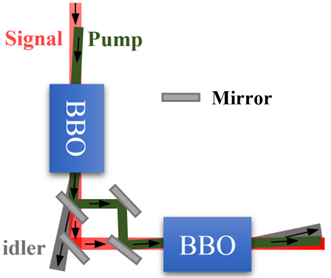
Optical parametric chirped-pulse amplification (OPCPA) has been a popular technique to amplify a broadband optical pulse. Due to the important advantages of OPCPA, some of the ultrafast petawatt laser facilities are constructed all based on this technique.
In a high power laser system, maximizing the pulse energy from a broadband pre-amplifier reduces the total gain narrowing in the system and yields the shortest available transform-limited compressed pulses. However, the conversion efficiency cannot easily increase to over 40% in the traditional OPCPA amplifier of one crystal scheme.
Recently, in National Laboratory on High Power Laser and Physics, Shanghai Institute of Optics and Fine Mechanics (SIOM), Chinese Academy of Sciences (CAS), the output ability of OPCPA pre-amplifier for a petawatt laser called Shen Guang-II 5PW (SG-II 5PW) facility had been overall improved.
To output higher signal pulse energy and maximize the pump-to-signal conversion efficiency while ensuring the gain of broadband, the research group, led by Professor ZHU Jianqiang, incorporated the concept of eliminating idler into the specific design of pre-amplifier structure and OPCPA configurations.
In their pre-amplifier structure, there are two traditional configuration OPCPA stages, and each amplification stage consists of two BBO crystals. Meanwhile, the effect of pump to signal spatial walk-off, which is related to beam quality and energy stability, is compensated in new designed OPCPA configuration.
The special design to the OPA configuration is that there are two crystals in one OPA stage, where the two BBO crystals are not cascade. The idler was separated after being amplified in the former BBO crystal, and only pump and signal were delivered to the other BBO crystal. They named it 'L' type configuration, and its effect to the OPCPA will be significant while the length of two crystals were specially designed.
Additionally, BBO crystal has the well-known large walk-off angle. To compensate the walk-off effect, the extraordinary axes of two BBO crystals in one stage were oriented in opposing directions, leading to the opposing pump to signal walk-off directions in two crystals.
In their experiment, the amplified signal energy was 160 mJ, the pump-to-signal efficiency in OPCPA stage 2 is over 43%, which is a quite high efficiency in one OPCPA amplifier.
Their findings can help further improve conversion efficiency by resolving the crucial obstacle of gain bandwidth narrowing and back conversion effect.
This work, entitled "Design and experimental demonstration of a high conversion efficiency OPCPA pre-amplifier for Petawatt Laser Facility" has been published in High Power Laser Science and Engineering.
This work was partially supported by the National Natural Science Foundation of China (NSFC).

Two BBO crystals OPCPA in 'L' type configuration (Image by SIOM)

86-10-68597521 (day)
86-10-68597289 (night)

86-10-68511095 (day)
86-10-68512458 (night)

cas_en@cas.cn

52 Sanlihe Rd., Xicheng District,
Beijing, China (100864)

